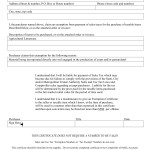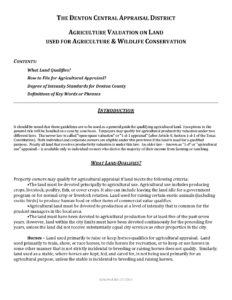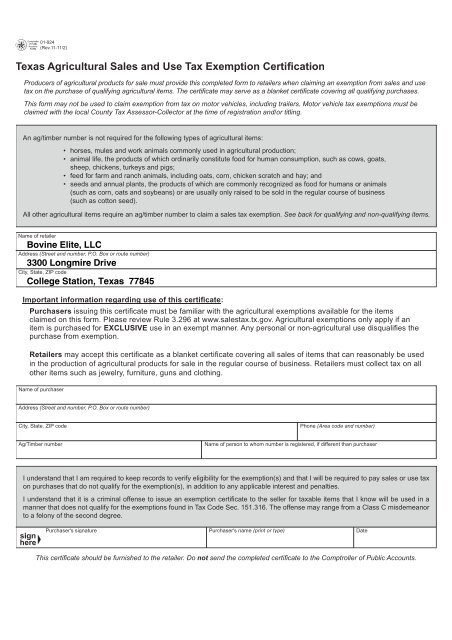
Land used primarily to train, show, or race horses, or to ride horses for recreation, or to keep or use horses in some manner that is not strictly incidental to breeding or raising horses. Some examples of Non-Qualifying Primary uses are: If more than one use occurs the most important or primary use must be agricultural. The land must be devoted principally to an agricultural use. Primary and Current Devotion to Agricultural Use Token agricultural use which occurs in an effort to obtain tax relief Raising cattle, goats, or sheep for FFA and 4H projects. Land used to train, show, or race horses, or to ride horses for recreation, or to keep or use horses in some manner that is not strictly incidental to breeding or raising horses. Personal consumption of crops or livestock produced by owner. Processing begins when activities occur that enhance the value of primary agricultural products. Processing begins at the first level of trade beyond production. Processing constitutes any activities that take place after the crop or animal has been raised and harvested and any activity a non-producer carries out on agricultural products. Land left idle for crop rotation qualifies until left idle for longer than the typical period. Land left idle to participate in a government program is used for agriculture. Participation in a government program and normal crop rotation. Raising livestock such as meat or dairy cattle, horses, goats, swine, poultry, and sheep. Production of crops for human consumption, animal feed, or production of fibers.Ĭultivation of ornamentals and flowering plants.Ĭultivation of fruits, vegetables, flowers, herbs, and other plants. See Texas Property Tax Code, 11.161.Īppurtenances to the land (canals, water wells, roads, stock tanks, and other similar reshaping of the soil) are included in the value of the land and not appraised separately. Farm and ranch equipment designed and used primarily for agricultural/husbandry activities are also exempt.

See Texas Property Tax Code, Section 11.16. Products in the hand of the producer are generally exempt from taxation.

The land beneath farm buildings and other agricultural improvements does qualify due to their use in connection with the agricultural process. All contiguous parcels, under the same ownership, will be considered as one piece of property.Īgricultural value applies only to the land and not to improvements (structures) on the land, minerals, or agricultural products. Exceptions to this guide will be handled on a case-by-case basis. It should be noted that these guidelines are to be used as a general guide for qualifying agricultural land.
#Texas ag exemption land requirements code#
The Texas Tax Code (TPTC), Sections 23.51 – 23.57 provide the core provisions for implementation. The legal basis for this type of special valuation called “Ag Use Open Space” or “1-d-1” is found in the Texas Constitution, Article VIII, Section 1-d-1. The Texas Constitution permits qualified open-space land to be taxed generally at a productivity value instead of market value. The “Manual for the Appraisal of Agricultural Land”, Property Tax Division, Comptroller of Public Accounts, January 2017, supports these guidelines. It is the opinion of the Williamson Central Appraisal District (WCAD) that the attached Agricultural Land Qualification Guidelines are valid for mass appraisal purposes and can be applied uniformly throughout the jurisdiction WCAD. Agricultural Land Qualification Guidelines The existence of a fiduciary duty does not prevent the rise of potential conflicts of interest.Applications are currently being accepted for Appraisal Review Board members for the 2024 tax appeal season. There are no guarantees that working with an adviser will yield positive returns. Working with an adviser may come with potential downsides such as payment of fees (which will reduce returns). All investing involves risk, including loss of principal. This is not an offer to buy or sell any security or interest.

We do not manage client funds or hold custody of assets, we help users connect with relevant financial advisors. SmartAsset does not review the ongoing performance of any RIA/IAR, participate in the management of any user’s account by an RIA/IAR or provide advice regarding specific investments.

SmartAsset’s services are limited to referring users to third party registered investment advisers and/or investment adviser representatives (“RIA/IARs”) that have elected to participate in our matching platform based on information gathered from users through our online questionnaire. Securities and Exchange Commission as an investment adviser. SmartAsset Advisors, LLC ("SmartAsset"), a wholly owned subsidiary of Financial Insight Technology, is registered with the U.S.


 0 kommentar(er)
0 kommentar(er)
